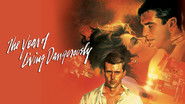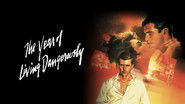Diagonaldi
Very well executed
SoftInloveRox
Horrible, fascist and poorly acted
Phonearl
Good start, but then it gets ruined
Sammy-Jo Cervantes
There are moments that feel comical, some horrific, and some downright inspiring but the tonal shifts hardly matter as the end results come to a film that's perfect for this time.
kathytexan-12585
Jill Bryant (Sigourney Weaver) tells Guy Hamilton (Mel Gibson) that his piece on the Lombok famine was melodramatic. She adds, "It's only my opinion. My flatmate was moved to tears..." I loved Guy's reply, "What does it take to bring you to tears, eh?" Greet tension simmering between them.I saw this movie when it first came out and it blew me away. I just watched it again after 35 tears and I'm so glad to see it has held up well. Great storytelling on many levels. Excellent performances all around, including a great supporting cast. Thank you TCM for airing this during the 31 Days of Oscar (2018)!
JohnHowardReid
NOTES: Linda Hunt won the Best Supporting Actress Awards from the Academy of Motion Picture Arts and Sciences, the Australian Film Institute, the Boston Society of Film Critics, the Los Angeles Film Critics Association, the National Board of Review, and the New York Film Critics. She also won the Australian Film Institute Jury Award. The movie also received nominations for AFI Awards in the following categories: Best Film, Best Director, Best Screenplay, Best Cinematography, Best Art Direction, Best Film Editing, Best Music Score, Best Costumes, Best Actor (Mel Gibson), and Best Sound. Negative cost: $6 million.MGM's claim that this movie was the first Australian film to be financed by a U.S. company is, of course, absolute rubbish. Rangle River (1936) was the first Oz movie to be financed entirely by a Hollywood company (Columbia), though U.S. companies did invest in previous Australian movies such as Get-Rich-Quick Wallingford (1915) starring Fred Niblo, and Venus of the South Seas (1924) starring Annette Kellerman. In the sound period, Universal invested in A Ticket in Tatts (1934) and at least six or seven other films during the 1930s. The important film in this decade, however, is the previously mentioned Rangle River (1936) which received an enormous amount of local publicity. During the 1940s only Smithy (1946) (Columbia) was wholly financed by Hollywood. In the following decades of the 1950s and 1960s, a number of Australian films were partly financed by Hollywood companies, but only ten were made with 100% Hollywood money: The Kangaroo Kid (1950) (Embassy), Kangaroo (1951) (20th Century-Fox), Long John Silver (1954) (Joseph Kaufman/20th Century-Fox), Smiley (1956) and its sequel, Smiley Gets a Gun (1958) (both 20th Century-Fox), On the Beach (1959) (Stanley Kramer/United Artists), Summer of the 17th Doll (1959) (Hecht-Hill- Lancaster/United Artists), The Sundowners (1960) (Warner Bros.), Port of Escape (1961) (John Calvert), Color Me Dead (1968) (Commonwealth United/Metro-Goldwyn-Mayer). Of course a number of Oz movies of the 40s, 50s and 60s were wholly financed by British studios, but that is another story, though I should mention The Shiralee (1957), wholly financed by Ealing/MGM British! The moral of this survey is: Though always strong on hyperbole, MGM's publicity department was occasionally light on facts.COMMENT: Anyone expecting an atmospheric vision and pictorially imaginative exposition of South-East Asia is going to be a bit disappointed. True, there are some great scenes, but with one or two exceptions the pictorial richness of "Picnic at Hanging Rock" is missing and a lot of the time it is composer Maurice Jarre rather than the director (or the photographer) who is working hard to convey atmosphere and dramatic impact. Instead Weir has opted to concentrate a lot of his attention on his characters. Unfortunately they are not a particularly interesting lot. Perhaps with a different cast, something dramatic, something expressive of the tension and conflict expressed in some of the dialogue and situations might have come across despite the unhelpful hand of the director. But with players like Mel Gibson, Noel Ferrier, the dwarf, and even normally reliable people like Michael Murphy, the battle for our attention is lost. Because the characters are so uninteresting, the film seems much longer than it is and there is little drama and atmosphere despite the sometimes well-filled CinemaScope screen of milling crowds and agitated mobs.
AaronCapenBanner
Peter Weir directed this account of the Indonesian revolution of 1965, which sees inexperienced Australian foreign correspondent Guy Hamilton(played by Mel Gibson) covering this story, with the help of a dwarf photographer(played by Linda Hunt, who won a best supporting actress Academy Award playing a man!) who has come to care deeply about the country, though will feel betrayed by its outcome. Sigourney Weaver plays an embassy aide who becomes romantically involved with Guy, who also helps him with the story, though events will spiral out-of-control, endangering all their lives... Moderately interesting film has solid performances, though the story is unfocused, and only sporadically powerful. Still, mostly worthwhile.
charishankar
Political thrillers are not my cup of tea. World history does not fascinate me. I'm a simple guy who likes his stories - whether on the written page or the silver screen - simple. I prefer fiction to fact.Which is why, perhaps, I am not in a position to comment on the qualities of 'The Year of Living Dangerously' as a political film, dealing with the troubled times in Indonesia at the time of the overthrow of President Sukarno in the 1960's. About how faithful it remains to the ground facts and realities of the situation as it then existed, I know nothing.And therein lies the strength of this film. Peter Weir has, in 'The Year of Living Dangerously', crafted a piece of cinema which, to say the least, is strikingly atmospheric. The viewer is plunged headlong into life in Jakarta as it was then, to a point where, at times, the experience becomes frankly cathartic. The scenes are authentically shot, obviously with care to be correct to the last detail, and at times it becomes difficult to analyze how Weir managed it all. And to do him credit, Mel Gibson, in one of his earlier appearances, manages a remarkably credible performance as the enterprising, if somewhat maverick, journalist Guy Hamilton, and is convincingly supported by Sigourney Weaver, who, despite being essentially his love interest and nothing more, is dependable as always.Where, perhaps, the film does falter, at times, is in putting the pieces together, so that it transcends the "docudrama" genre and becomes epic. A bit more continuity, here and there, might have gained the movie a few more brownie points.And then, of course, there's Billy Kwan. An astonishing portrayal, of one of the most intense characters I have seen in cinema. 'The Year of Living Dangerously' is worth watching even for the sheer experience of absorbing Linda Hunt's enactment of the mercurial character, for, believe me, it's a tour de force if there ever was one - a portrayal which permeates into you at so many levels, it's difficult to make out where Hunt ends and Kwan begins. That it is a male character essayed by a female artist is of course creditable; it is, however, another triumph for Hunt that she never lets us become aware of this. In the hands of a lesser performer it may have been reduced to a casting gimmick; in Linda Hunt's hands, it becomes one of the greatest performances ever seen on screen.I certainly feel kindlier towards political thrillers after watching this one. Perhaps you will, too.





